2018 TOYOTA TUNDRA gas type
[x] Cancel search: gas typePage 41 of 672

411-1. For safe use
1
For safety and security
Your vehicle is equipped with ADVANCED AIRBAGS designed based
on the US motor vehicle safety standards (FMVSS208). The airbag
sensor assembly (ECU) controls airbag deployment based on infor-
mation obtained from the sensors etc. shown in the system compo -
nents diagram above. This informat ion includes crash severity and
occupant information. As the airbags deploy, a chemical reactio n in
the inflators quickly fills the airbags with non-toxic gas to h elp restrain
the motion of t he occupants.
Front bench type seat: The SRS airbags are designed to protect the
driver and right front passenger, and they are not designed to protect
an occupant in the front c enter seating position.
Page 75 of 672
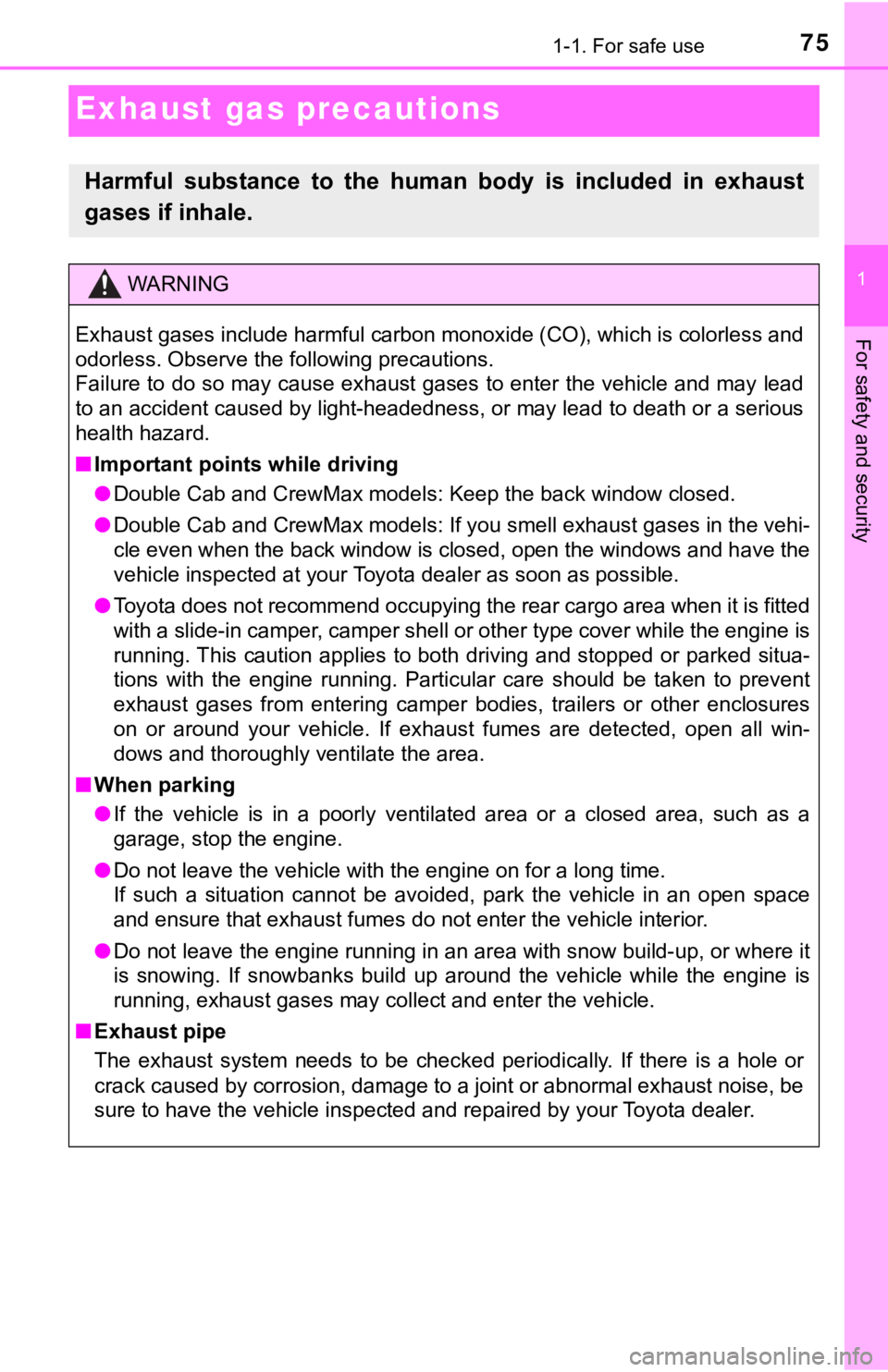
751-1. For safe use
1
For safety and security
Exhaust gas precautions
Harmful substance to the human body is included in exhaust
gases if inhale.
WARNING
Exhaust gases include harmful carbon monoxide (CO), which is colorless and
odorless. Observe the following precautions.
Failure to do so may cause exhaust gases to enter the vehicle a nd may lead
to an accident caused by light-headedness, or may lead to death or a serious
health hazard.
■ Important points while driving
● Double Cab and CrewMax models: Keep the back window closed.
● Double Cab and CrewMax models: If you smell exhaust gases in th e vehi-
cle even when the back window is closed, open the windows and h ave the
vehicle inspected at your Toyota dealer as soon as possible.
● Toyota does not recommend occupying the rear cargo area when it is fitted
with a slide-in camper, camper shell or other type cover while the engine is
running. This caution applies to both driving and stopped or pa rked situa-
tions with the engine running. Particular care should be taken to prevent
exhaust gases from entering camper bodies, trailers or other enclosures
on or around your vehicle. If exhaust fumes are detected, open all win-
dows and thoroughly ventilate the area.
■ When parking
● If the vehicle is in a poorly ventilated area or a closed area, such as a
garage, stop the engine.
● Do not leave the vehicle with the engine on for a long time.
If such a situation cannot be avoided, park the vehicle in an o pen space
and ensure that exhaust fumes do not enter the vehicle interior .
● Do not leave the engine running in an area with snow build-up, or where it
is snowing. If snowbanks build up around the vehicle while the engine is
running, exhaust gases may collect and enter the vehicle.
■ Exhaust pipe
The exhaust system needs to be checked periodically. If there is a hole or
crack caused by corrosion, damage to a joint or abnormal exhaust noise, be
sure to have the vehicle inspected and repaired by your Toyota dealer.
Page 221 of 672
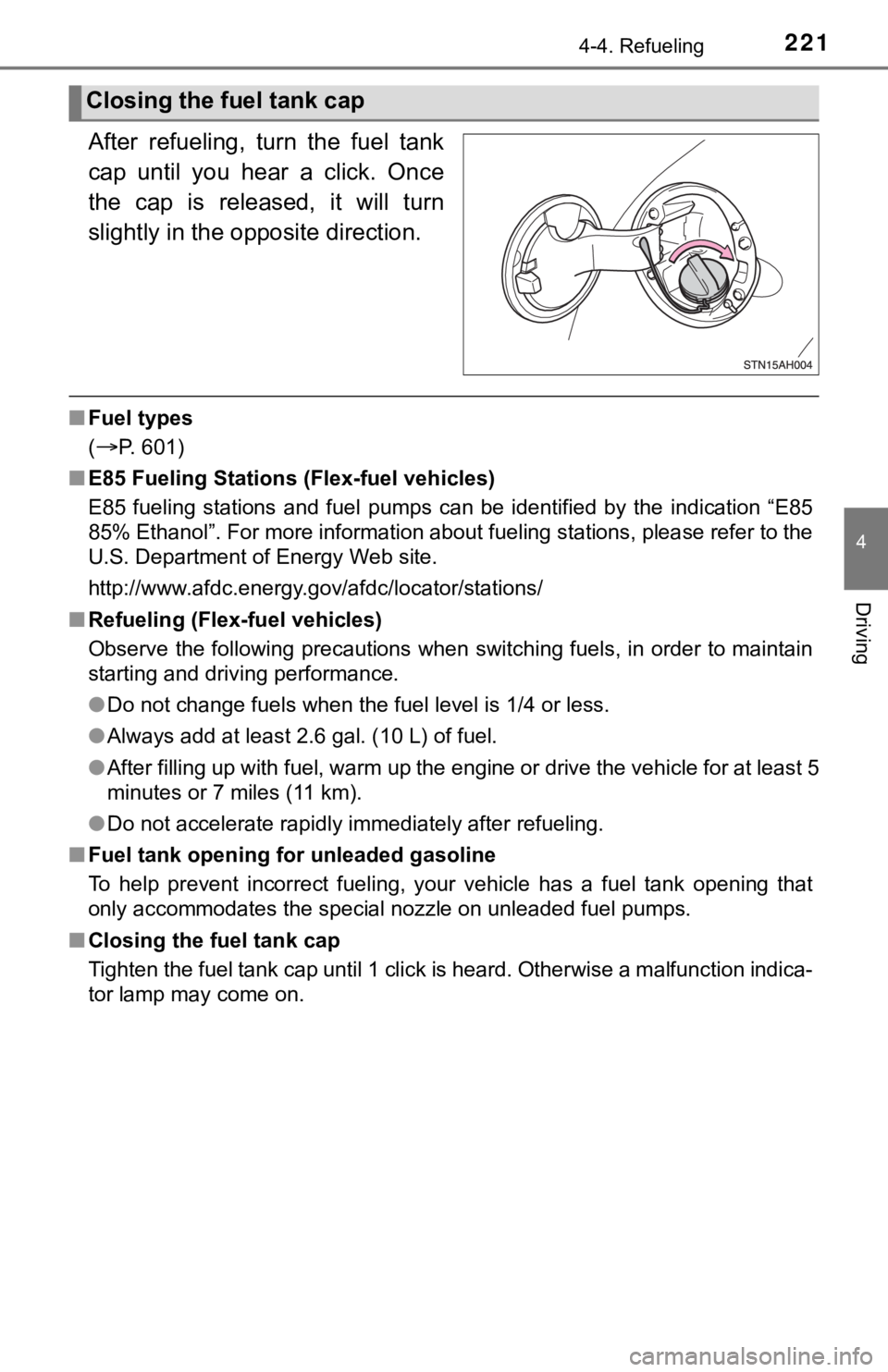
2214-4. Refueling
4
Driving
After refueling, turn the fuel tank
cap until you hear a click. Once
the cap is released, it will turn
slightly in the opposite direction.
■Fuel types
(
P. 601)
■ E85 Fueling Stations (Flex-fuel vehicles)
E85 fueling stations and fuel pumps can be identified by the in dication “E85
85% Ethanol”. For more information about fueling stations, plea se refer to the
U.S. Department of Energy Web site.
http://www.afdc.energy.gov/afdc/locator/stations/
■ Refueling (Flex-fuel vehicles)
Observe the following precautions when switching fuels, in order to maintain
starting and driving performance.
●Do not change fuels when the fuel level is 1/4 or less.
● Always add at least 2.6 gal. (10 L) of fuel.
● After filling up with fuel, warm up the engine or drive the vehicle for at least 5
minutes or 7 miles (11 km).
● Do not accelerate rapidly immediately after refueling.
■ Fuel tank opening for unleaded gasoline
To help prevent incorrect fueling, your vehicle has a fuel tank opening that
only accommodates the special nozzle on unleaded fuel pumps.
■ Closing the fuel tank cap
Tighten the fuel tank cap until 1 click is heard. Otherwise a m alfunction indica-
tor lamp may come on.
Closing the fuel tank cap
Page 475 of 672
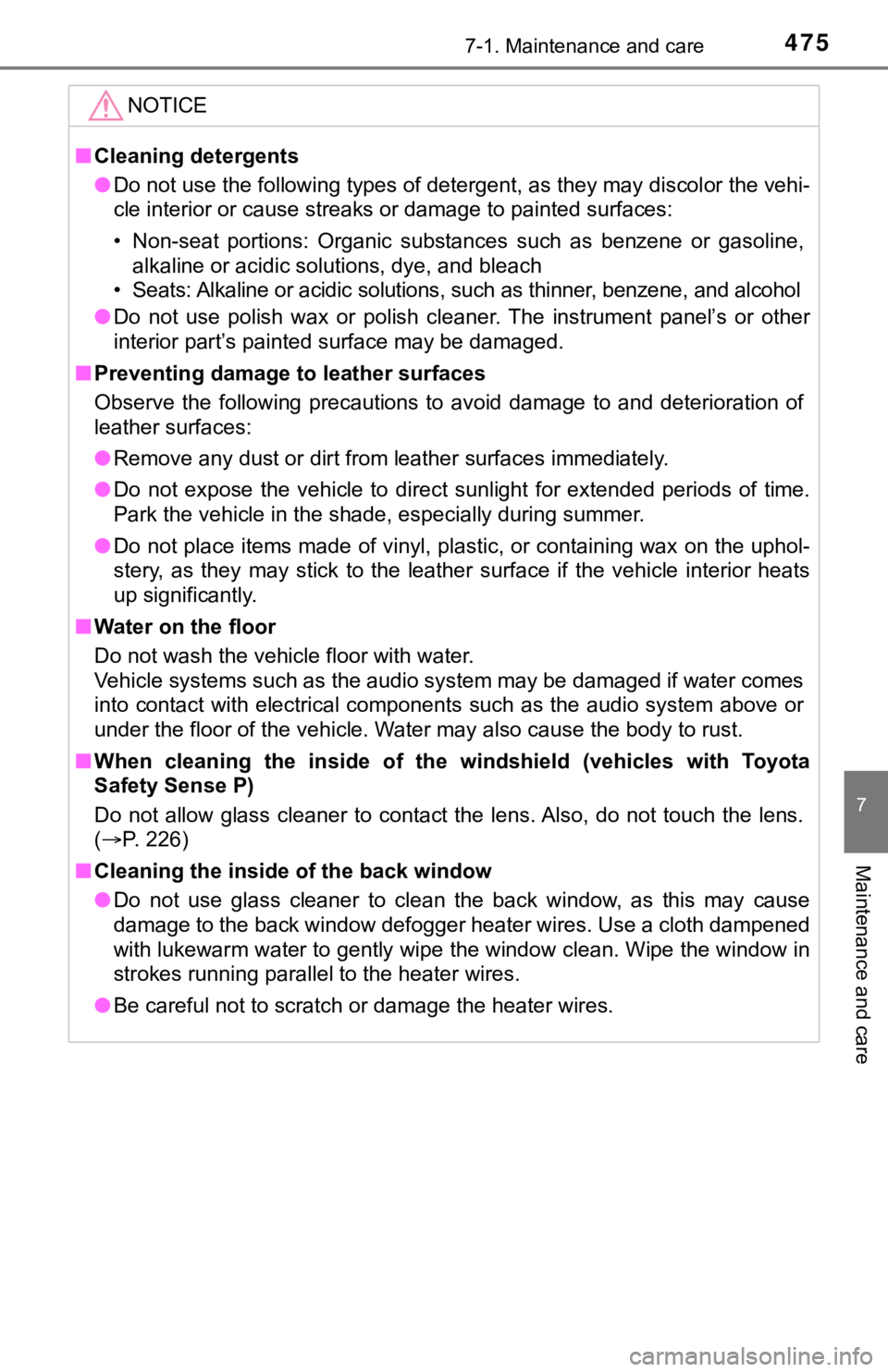
4757-1. Maintenance and care
7
Maintenance and care
NOTICE
■Cleaning detergents
● Do not use the following types of detergent, as they may discol or the vehi-
cle interior or cause streaks or damage to painted surfaces:
• Non-seat portions: Organic substances such as benzene or gasol ine,
alkaline or acidic solutions, dye, and bleach
• Seats: Alkaline or acidic solutions, such as thinner, benzene, and alcohol
● Do not use polish wax or polish cleaner. The instrument panel’s or other
interior part’s painted surface may be damaged.
■ Preventing damage to leather surfaces
Observe the following precautions to avoid damage to and deterioration of
leather surfaces:
● Remove any dust or dirt from leather surfaces immediately.
● Do not expose the vehicle to direct sunlight for extended perio ds of time.
Park the vehicle in the shade, especially during summer.
● Do not place items made of vinyl, plastic, or containing wax on the uphol-
stery, as they may stick to the leather surface if the vehicle interior heats
up significantly.
■ Water on the floor
Do not wash the vehicle floor with water.
Vehicle systems such as the audio system may be damaged if wate r comes
into contact with electrical components such as the audio syste m above or
under the floor of the vehicle. Water may also cause the body to rust.
■ When cleaning the inside of the windshield (vehicles with Toyota
Safety Sense P)
Do not allow glass cleaner to contact the lens. Also, do not to uch the lens.
( P. 226)
■ Cleaning the inside of the back window
● Do not use glass cleaner to clean the back window, as this may cause
damage to the back window defogger heater wires. Use a cloth da mpened
with lukewarm water to gently wipe the window clean. Wipe the w indow in
strokes running parallel to the heater wires.
● Be careful not to scratch or damage the heater wires.
Page 601 of 672

6019-1. Specifications
9
Vehicle specifications
Engine
Model1UR-FE, 3UR-FE, 3UR-FBE
Ty p e8-cylinder V-type, 4-cycle, gasoline
Bore and stroke
1UR-FE engine
3.70 3.27 in. (94.0 83.0 mm)
3UR-FE and 3UR-FBE engines
3.70 4.02 in. (94.0 102.0 mm)
Displacement
1UR-FE engine
281.2 cu.in. (4608 cm
3)
3UR-FE and 3UR-FBE engines
345.6 cu.in. (5663 cm
3)
Drive belt tensionAutomatic adjustment
Valve clearance
(engine cold)Automatic adjustment
Fuel
EngineModel1UR-FE and 3UR-FE
engines3UR-FBE engine
Ty p eGasoline engineFlex-fuel engine
Fuel typeUnleaded gasoline only
Unleaded gasoline,
E85, or a blend of the two fuels
Octane rating
(Unleaded gasoline)87 (Research Octane Number 91) or higher
Ethanol percentage
(E85)—85% or less
Fuel tank capacity
(Reference)
Standard fuel tank: 26.4 gal. (100.0 L, 22.0 Imp.gal.)
Large fuel tank: 38.0 gal. (144.0 L, 31.7 Imp.gal.)
Page 613 of 672
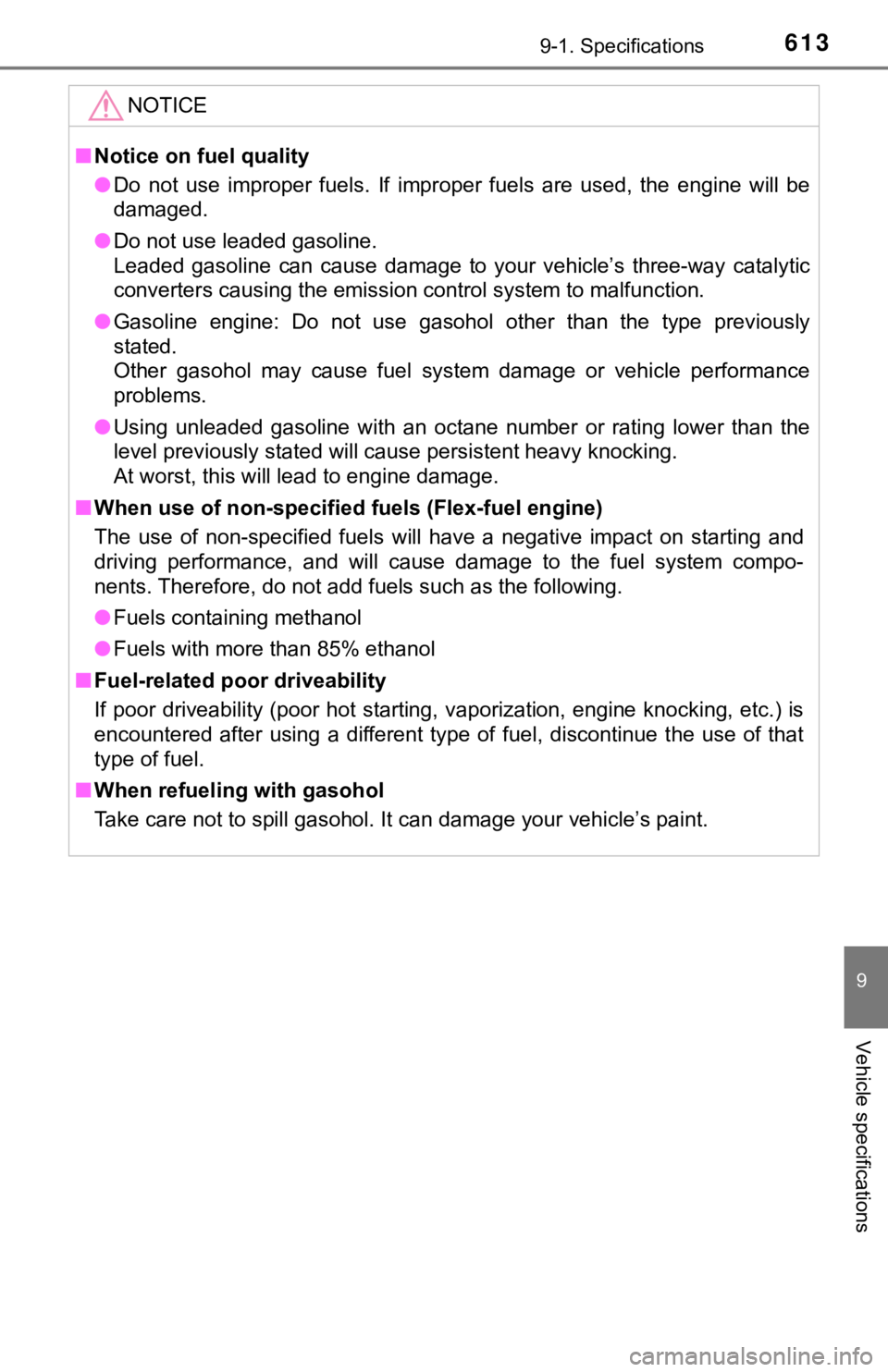
6139-1. Specifications
9
Vehicle specifications
NOTICE
■Notice on fuel quality
● Do not use improper fuels. If improper fuels are used, the engi ne will be
damaged.
● Do not use leaded gasoline.
Leaded gasoline can cause damage to your vehicle’s three-way ca talytic
converters causing the emission control system to malfunction.
● Gasoline engine: Do not use gasohol other than the type previou sly
stated.
Other gasohol may cause fuel system damage or vehicle performan ce
problems.
● Using unleaded gasoline with an octane number or rating lower than the
level previously stated will cause persistent heavy knocking.
At worst, this will lead to engine damage.
■ When use of non-specified fuels (Flex-fuel engine)
The use of non-specified fuels will have a negative impact on s tarting and
driving performance, and will cause damage to the fuel system c ompo-
nents. Therefore, do not add fuels such as the following.
● Fuels containing methanol
● Fuels with more than 85% ethanol
■ Fuel-related poor driveability
If poor driveability (poor hot starting, vaporization, engine k nocking, etc.) is
encountered after using a different type of fuel, discontinue the use of that
type of fuel.
■ When refueling with gasohol
Take care not to spill gasohol. It can damage your vehicle’s paint.
Page 661 of 672

661Alphabetical index
Engine immobilizer system ...... 76
Engine oil ................................. 486Capacity ................................ 602
Checking ............................... 486
Preparing and checking
before winter....................... 312
Engine oil maintenance
data ......................................... 477
Engine switch (ignition switch)..................... 195
Engine switch light (ignition switch light) ............ 429
Event data recorder (EDR) ........ 10
FFV .................................... 221, 610
Flat tire...................................... 565
Flex-fuel ............................ 221, 610
Flexible fuel vehicle......... 221, 610
Floor mats .................................. 28
Fluid Automatic transmission......... 606
Brake .................................... 607
Washer ................................. 494
Fog lights ................................. 216
Replacing light bulbs............. 530
Switch ................................... 216
Wattage ................................ 609
Foot well light .......................... 429
Four-wheel drive system ........ 296
Front passenger occupant classification system .............. 50
Front personal lights ............... 430
Front seats ............................... 123 Adjustment ............................ 123
Cleaning................................ 473
Correct driving posture ........... 30
Driving position memory ....... 128
Head restraints ..................... 132
Power easy access system ......... ....................... 128
Seat heaters ......................... 426
Seat position memory ........... 128 Seat ventilators ..................... 426
Front side marker lights Light switch ........................... 206
Replacing light bulbs ............ 528
Wattage ................................ 609
Front turn signal lights Replacing light bulbs ............ 527
Turn signal lever ................... 204
Wattage ................................ 609
Fuel ........................................... 601
Capacity................................ 601
Fuel gauge.............................. 95
Fuel pump shut off system ... 546
Gas station information......... 672
Information............................ 610
Refueling .............................. 220
Type.............................. 221, 601
Warning light......................... 548
Warning message................. 558
Fuel consumption Average fuel consumption ....................... 107
Current fuel consumption ..... 107
Fuel filler door ......................... 220
Fuel pump shut off system..... 546
Fuses ........................................ 518
Garage door opener ................ 456
Gas station information .......... 672
Gauges ....................................... 95
Glove box ................................. 434
F
G
Page 672 of 672
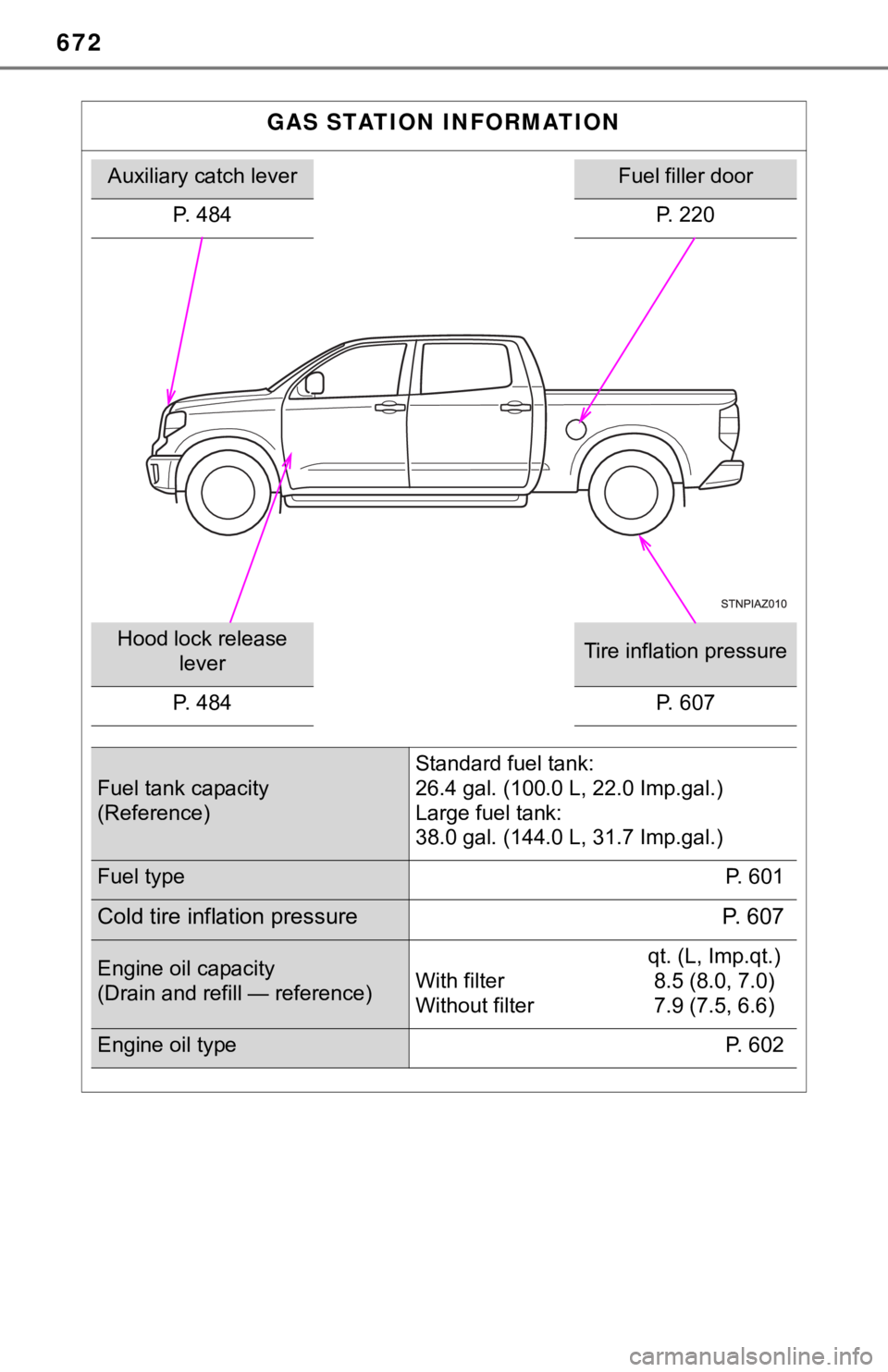
672
GAS STATION INFORMATION
Auxiliary catch leverFuel filler door
P. 484 P. 220
Hood lock release leverTire inflation pressure
P. 484
P. 607
Fuel tank capacity
(Reference) Standard fuel tank:
26.4 gal. (100.0 L, 22.0 Imp.gal.)
Large fuel tank:
38.0 gal. (144.0 L, 31.7 Imp.gal.)
Fuel type
P. 601
Cold tire inflation pressureP. 607
Engine oil capacity
(Drain and refill — reference)qt. (L, Imp.qt.)
With filter 8.5 (8.0, 7.0)
Without filter 7.9 (7.5, 6.6)
Engine oil type P. 602